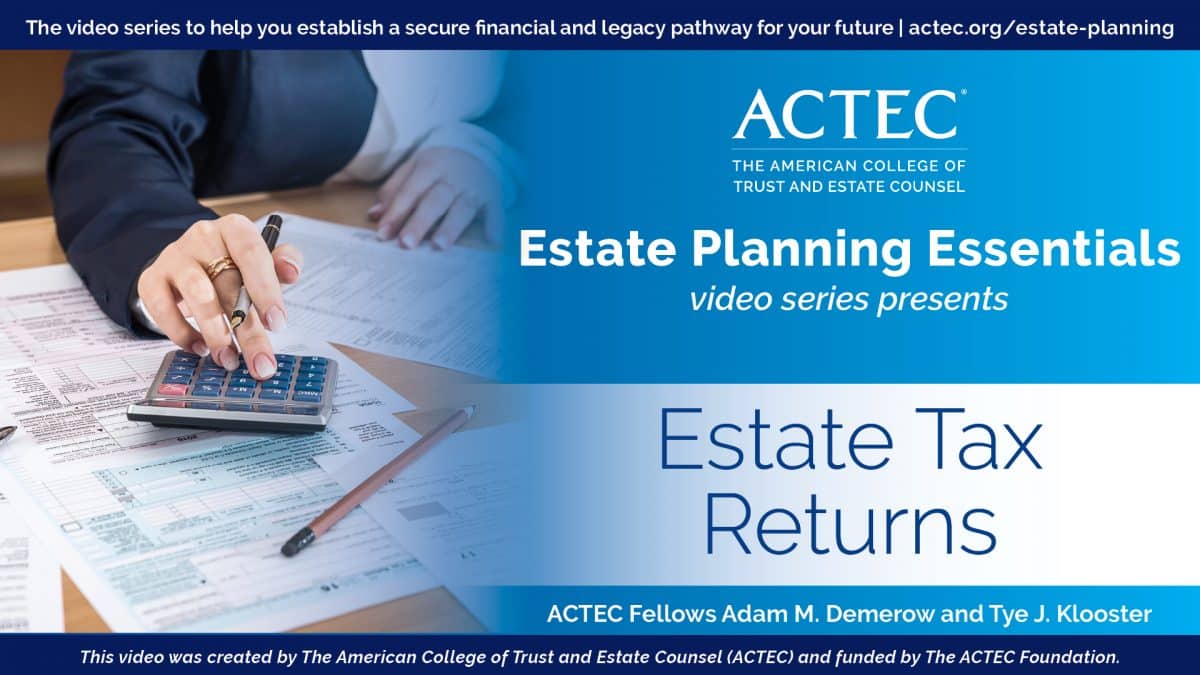Fiduciary income tax is a tax imposed on the income earned by certain types of legal entities, such as trusts and estates, while they hold and manage assets on behalf of beneficiaries. These entities are responsible for filing tax returns and paying taxes on the income generated within the trust or estate, ensuring that beneficiaries receive their distributions after accounting for tax liabilities.
ACTEC Fellows Farhad Aghdami and Lora G. Davis have all the answers and explain the difference between estate and fiduciary income tax and why estates always file two tax returns.
Transcript
Hello. I’m Lora Davis, an ACTEC Fellow from Dallas, Texas and I’m here Farhad Aghdami an ACTEC Fellow from Richmond, Virginia. Today were going to talk about the basics of fiduciary income taxation. Farhad, what does fiduciary income taxation mean?
Good morning, Lora. It’s good to see you again. Fiduciary income taxation is really the income taxation of estates and trusts and that should be contrasted with the estate tax. I know we use those terms somewhat interchangeably, but when we’re talking about fiduciary income taxation we’re really talking about the income taxation of the assets that are in a person’s estate or the income taxation of assets that are held in a trust. And this should be contrasted with the estate tax, which is really sort of a one-time tax that occurs at a person’s death. I’ll use a simple example, or simple analogy to explain the distinction. Think about a farmer who owns an apple orchard and the farmer passes away. There may be an estate tax due on the value of that apple orchard and you’d have an appraiser determine what the value is and you would subtract any applicable deductions in a credit- there’s an $11.7 million estate tax credit that’s available- and that’s sort of a one-time tax that’s paid. The fiduciary income taxation, though, is the tax on what is generated by that property. If you’ve got an apple orchard, you’re growing apples every year and the income is really the apples that are being grown every year. That’s what’s being generated from the property and so you file an annual income tax return reporting the income that’s generated by the property.
So, let’s parse it out a little bit. Can you explain exactly what an estate is?
Sure, so when a person passes away the assets that they own, that they owned at the time of their death, are held in their estate. And the estate really captures all of the income – the fiduciary income tax return captures all the income- that’s earned during the period of estate administration, really from the moment of death until the assets are distributed to the beneficiary. So, if a person dies let’s say on May 17, all the income that they earned from January 1 to May 17, while they are alive, will be reported on Form 1040 in their personal income tax return. Then, all the income starting from May 17 through the end of the year would be captured on a Form 1041, which is the fiduciary income tax.
OK, that makes sense. And so what’s a trust?
A trust is really an arrangement where property is transferred to a person, who’s known as the trustee, and they hold and manage the property subject to the terms of the trust agreement, typically in writing, for the benefit of the beneficiary, and the trustee owes certain fiduciary duties to the beneficiary. Trusts can be revocable, that is, they can be amended, changed or revoked, or they can be irrevocable. Often revocable trusts are used as will substitutes, and they’re often referred to as living trusts, whereas irrevocable trusts are created during lifetime often for gift planning purposes where you want to make a transfer to an irrevocable trust to make sure that a gift is complete for gift tax purposes. Also revocable trusts become irrevocable at a person’s death because they can no longer be amended her changed.
So, there’s lots of different kinds of trusts. From an income tax perspective, how are trusts generally taxed?
Generally, they really work with what I call a modified conduit form of taxation. And the way I sort of think about it is if the dollar income flows into the trust and the trustee holds onto that income, then the trust pays taxes on income. If the trustee turns on the faucet and says, “hey we’re going to allow this dollar of income to flow down to the beneficiary, then beneficiary has received the income and they pay the tax on that and the trust gets an offsetting income distribution deduction.
So, from a tax perspective, trusts fall into three broad categories: simple trusts, complex trusts, and grantor trusts. Will you explain what those are?
A simple trust is a trust where all of the income must be distributed out to the beneficiary annually. So basically, if there’s any income, interest, dividends, rents, proceeds from the sale of apples, if that comes into the trust the trustee is obligated to distribute the income out to the beneficiary. A complex trust is trust where the trustee has discretion to either distribute some, all, or none of the income out to the beneficiary. And then there’s a third type of trust, which is called a grantor trust, and that’s a trust where actually the person who set up the trust, not the beneficiary, is taxed on the income. And there’s certain reasons why, certain powers, that cause a trust to be considered a grantor trust; and actually there’s a subset of grantor trusts where not the grantor, but the beneficiary is considered the owner of the trust income.
A lot of people ask if trusts are taxed a higher rate and we know the answer to that is no, but that is somewhat misleading. Will you explain how trusts are taxed differently than individuals?
Sure, so you’re absolutely right that trusts don’t pay tax at a higher rate, but they get to the higher rate much more quickly. In the case of a married couple that’s filing jointly, they don’t get to the top income tax rate of 37% (the top bracket) until they have about $628,000 of income in 2021. There’s a lot of income that doesn’t get taxed at the top rate, you have to get a $628,000. Whereas, in the case of a trust, you get to the top tax rate of 37% with only about $13,000 of taxable income. The trust tax rates are very compressed. So, keeping income inside a trust can be disadvantageous because many of the dollars are ultimately taxed at the highest rate. There is the ability to distribute income out to a beneficiary and it is important for trustees to monitor trust income because you could potentially distribute income out to the beneficiary at a lower tax rate.
That’s great information to have, Farhad. The tax return used for trusts and estates is a Form 1041. Who files that income tax return and when is it due?
Typically, the fiduciary- whether it’s the executor or personal representative of the estate or the trustee of the trust- they are responsible for preparing and filing the fiduciary income tax return, the Form 1041. That’s typically due on the fifteenth day of the fourth month following the close of the trust or estate’s taxable year. And in most calendar year trusts that will be April 15 of the year following in which the trust had it its prior year ended. Then, estates can be on a fiscal year as long as the first fiscal year is no longer than 12 months, and so you would be due on the fifteenth day of the fourth month following the end of that year.
Great, so how do beneficiaries report the income that they received from the estate or the trust?
The beneficiary reports the income they will receive from the trust or the estate on a Form K-1, which reports their share of the income, gain, loss, credit, deduction from the trust that is passed out to them. So, they’ll take that Schedule K-1 and they’ll entered the information from the K-1 on their personal return. That’s how they actually report that income.
So, does a trustee of a grantor trust always need to file a form 1041?
Not in all cases. There are really two methods. First you can prepare and file a grantor trust tax return which is really an abbreviated return. It just has the name of the trust, the trustee, and their address and then it is attached to sort of a list of items of income, gain, loss, credit, deduction. And those act like a K-1 for the grantor and they would report those on their personal return. And then, in some cases, a grantor trust return is not filed at all and all of the items are reported just directly on the grantor’s personal return.
Great, that seems a little bit easier than filing a return. So, can you explain again how fiduciary income taxation is different from estate taxation?
Sure. Estate taxation really looks at the value of a person’s estate at the moment of death. You sort of take a snapshot of the value of all the assets in their estate at the time of death and you value those and you subtract any deductions or any credits or exemptions, and as I mentioned there’s an $11.7 million estate tax exemption that is available. And that’s a one time tax that’s paid, it’s typically due nine months from the date of death. In the case of the fiduciary income taxation, that’s really on income that’s been generated by the assets in the estate and so I use the analogy of the apple orchard owner. If the farmer dies there is an estate taxes on the value of all of his trees and his farming operations, and the value of all of those and then you’d pay this one time estate tax. But also those trees are growing fruit each year and when that fruit is sold that is generating income and that’s where the fiduciary income tax would come into play and you’d report the income from all the apple proceeds.
Great. That’s helpful because I know it’s always confusing that there’s two estate tax returns. Farhad, thank you so much for your clear explanations of fiduciary income taxation and the Form 1041.
Thank you, Lora, it’s great see you. I really appreciate it.
Featured Video
Estate Tax Returns
Estate Planning experts give a step-by-step of the estate tax preparation and filing process, what's required, extensions, exemptions, and the IRS' response.
ACTEC Estate Planning Essentials

ACTEC Fellows provide answers to frequently asked trust and estate planning questions in this video series.



